Class 10 ICSE Physics Specimen 2023
Maximum Marks: 80
Time allowed: Two hours
Answers to this Paper must be written on the paper provided separately.
You will not be allowed to write during first 15 minutes.
This time is to be spent in reading the question paper.
The time given at the head of this Paper is the time allowed for writing the answers.
Section A is compulsory.
Attempt any four questions from Section B.
The intended marks for questions or parts of questions are given in brackets [ ].
Section-A
(Attempt all questions from this Section.)
Question 1
Choose one correct answer to the questions from the given options:
(i) S.I. unit of moment is:
(a) kgf.m
(b) Nm
(c) gf.m
(d) Nem
Solution

(ii) Which of the following is the correct expression for gain in kinetic energy, if initial
velocity is not zero?
(i) K = 1/2 mv2
(ii) K = (mv2)/4
(iii) K = (mv2)/2t
(iv) K = 1/2 m(v2-u2)
Solution

(iii) The energy conversion, when an oscillating pendulum moves from mean to extreme
position is:
(a) Kinetic to potential
(b) Potential to kinetic
(c) Potential to kinetic to potential
(d) Kinetic to potential to kinetic
Solution

(iv) Which of the following nuclear radiations can be stopped by a sheet of paper?
(a) Alpha
(b) Beta
(c) Gamma
(d) None of these
Solution

(v) When seven spectral colours passes through a glass block from air, then which one
of the following statements is correct.
(a) In the glass block, speed of blue light > speed of yellow light.
(b) In the glass block, speed of green light > speed of orange light.
(c) In block, speed of violet light > speed of red light.
(d) In the glass block, speed of orange light > speed of indigo light.
Solution

(vi) In which of the following diagrams is the refraction not correct:
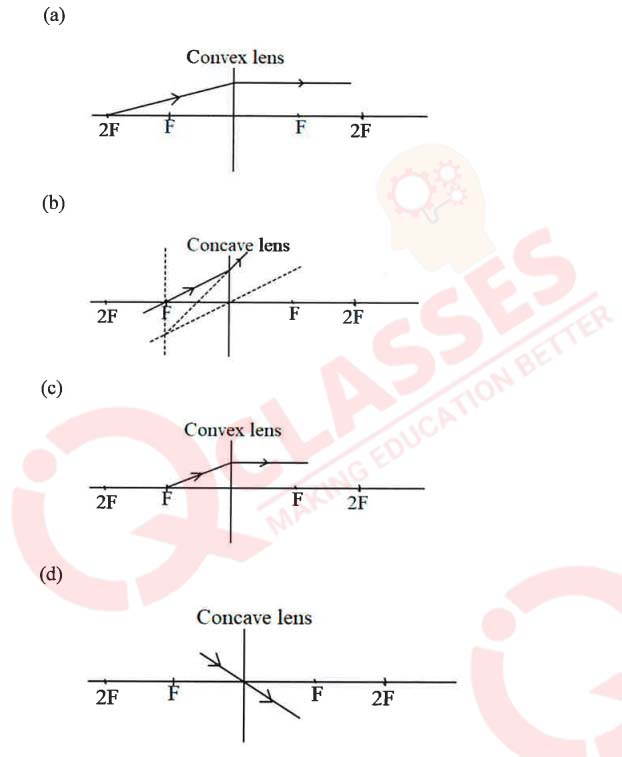
Solution

(vii) The characteristics of sound which enables to differentiate between two sounds of
different intensity is:
(a) Quality
(b) Amplitude
(c) Pitch
(d) Loudness
Solution

(viii) The ratio of the wavelength of A : wavelength of B is:

(a) 5:2
(b) 1:2
(c) 2:1
(d) 2:3
Solution

(ix) The graph shows I against V relation for three conductors A, B and C. Choose the
correct relation for the resistors of A, B and C.
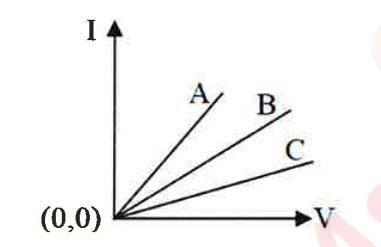
(a) RA>RB>RC
(b) RB>RC
< RA
(c) RC>RB
< RA
(d) RC>RB>RA
Solution


(x) Which of the following is the correct colour code of the three wires live, neutral and
earth?
(a) Live: Green Neutral: Red Earth: Yellow
(b) Live: Brown Neutral: Red Earth: blue
(c) Live: Brown Neutral: blue Earth: Yellow
(d) Live: Blue Neutral: Brown Earth: Green
Solution

(xi) When a conductor carrying current is placed in a magnetic field, perpendicular to it
then the direction of the force experienced can be found out using:
(a) Lenz’s law
(b) Fleming’s left hand rule
(c) Flemings right hand rule
(d) Right hand thumb rule
Solution

(xii) Choose the correct statement.
Latent heat absorbed:
(a) is independent of the mass of the substance.
(b) is directly proportional to the increase in the temperature of the substance.
(c) is directly proportional to the specific heat capacity of the substance.
(d) is directly proportional to the specific latent heat of the substance.
Solution

(xiii) Which of the following liquids is most suitable for radiators in cars?
(a) Liquid P with specific heat capacity 4000 Jkg-1K-1.
(b) Liquid Q with specific heat capacity 2000 Jkg-1K-1.
(c) Liquid R with specific heat capacity 1500 Jkg-1K-1.
(d) Liquid S with specific heat capacity 2100 Jkg-1K-1.
Solution

(xiv) While entering from medium A to medium B if light slows down then:
(a) ∠i < ∠r
(b) ∠i = ∠r
(c) ∠i > ∠r
(d) ∠i ≤ ∠r
Solution

(xv) The phenomenon of light that causes the diamond to glitter is:
(a) Refraction
(b) Total internal reflection.
(c) Reflection.
(d) Absorption.
Solution

Question 2
(i) (a) How many pulleys are there in a movable block of a block and tackle system [3]
with velocity ratio 5?
(b) A radioactive nucleus emits a beta particle. Does the position of daughter
nucleus change in a periodic table as compared to the parent nucleus?
(c) To which electrically charged plate the beta radiations will deflect while
passing through an electric field?
Solution


(ii) (a) Name the force which produces maximum moment about.
(b) Calculate this moment in SI unit.
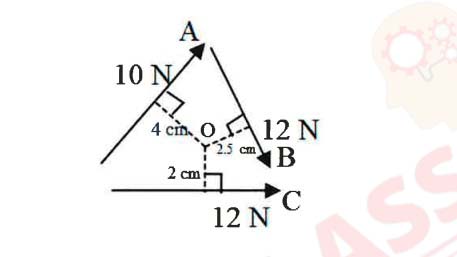
Solution

(iii) State two factors that affects the centre of gravity of the body.
Solution

(iv) If the moment of F about the centre of a wheel O is 6 Nm then calculate the moment
of F about A.
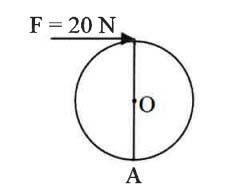
Solution

(v) If kinetic energy of a moving body is 40J then what will be its kinetic energy when its velocity is doubled?
Solution

(vi) A freely suspended pendulum in air is disturbed once and left to oscillate on its own:
(a) Name the type of vibrations.
(b) State one way to decrease the frequency of this vibration.
Solution

(vii) Two copper wires A and B are of same length present at temperature 30°C. Radius
of A is twice the radius of B.
(a) Which wire has greater resistance?
(b) Which wire will have greater resistivity?
Solution

Question 3
(i) A lens X can form an image on the screen.
(a) Name the lens X.
(b) Is it possible for this lens to form magnified image?
Solution

(ii) (a) Is it possible to switch off an appliance by placing the switch in a neutral wire?
(b) Is it possible for current to flow between a neutral and an earth wire?
Solution

(iii) State two factors that affect the strength of an electromagnet.
Solution

(iv) Calculate the heat absorbed by 200 g ice at 0°C to change to water at 60°C. [Specific heat capacity of ice = 2100 J kg-1 K-1, Specific heat capacity of water = 4200 J kg-1 K-1, Specific latent heat of ice = 336000 J-1kg-1].
Solution

(v) What are background radiations?
Solution

Section-B
(Attempt any four questions from this Section.)
Question 4
(i) The diagram (not drawn to the scale) below shows the graphical relation between
angle of deviation and angle of incidence, when light passes through a triangular
prism of angle 62° of a certain glass material.

(a) State the angle of minimum deviation of this prism and the corresponding
angle of incidence.
(b) Calculate the value of X.
Solution

(ii) Redraw and complete the path of the ray AB till it emerges out of the prism of
critical angle 42°.
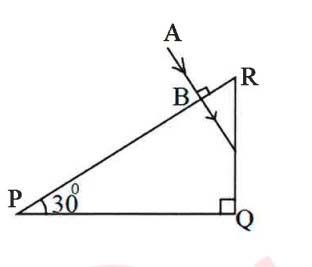
Solution


(iii)

The above diagram shows that an observer sees the image of an object O at I.
(a) Name and define the phenomenon responsible for seeing the image at a
different position.
(b) State the effect on X when:
1. Y increases
2. Y decreases
Solution

Question 5
(i) An object of height 20 cm is placed in front of a lens at a distance of 50 cm. Its
virtual, diminished image is formed at a distance of 15 cm.
(a) Identify the type of the lens.
(b) Calculate the focal length of the lens.
Solution


(ii) The diagram below shows the extreme colours of a visible spectrum (X and Y).
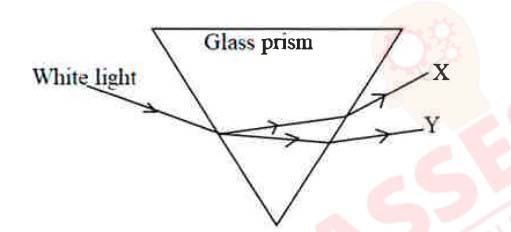
(a) Identify the colours X and Y.
(b) Which colour has greater speed in vacuum?
Solution

(iii)The diagram below shows an object AB kept in front of the lens. The path of one
ray coming from the object is shown.

(a) Name the lens L.
(b) Redraw and complete the ray diagram showing the formation of the image.
(c) In which optical instrument is this kind of image formed?
Solution

Question 6
(i) The diagram below shows a block and tackle system:
(a) Copy and redraw the labelled diagram showing the correct connection of
tackle, direction of the forces involved to obtain the maximum V.R. and
convenient direction.
(b) Calculate the M.A. of this pulley system if its efficiency is 80%.

(ii) The adjacent diagram shows a wheel of diameter 40 cm fixed on a wall capable of
rotating around its centre O. If the wheel rotates in an anticlockwise direction,
then:
(a) Calculate the clockwise moment.
(b) State whether X = 100 gf or X < 100 gf or X> 100 ef.
(c) Give a reason for your answer.

(iii) A coconut of mass 450 g falls from the top of an 80 m high tree.
(a) Calculate the potential energy possessed by the coconut when it'is at the top of
the tree.
(b) Without calculation, state the kinetic energy with which it strikes the ground
and state the principle involved to arrive at the answer in (i) g = 10 ms2?
Solution
(i)


(ii)

(iii)

Question 7
(i) A person standing in front of a cliff fires a gun and hears its echo after 3s. If the
speed of sound in air is 336 ms-1.
(a) Calculate the distance of the person from the cliff.
(b) After moving a certain distance from the cliff he fires the gun again and this
time the echo is heard 1.5 s later than the first. Calculate distance moved by
(ii) (a) A radioactive nucleus X emits an alpha particle followed by two beta particles
and forms nucleus Y. What is the general name of the elements X and Y?
(b) If the atomic number of Y is 80 then what is the atomic number of X?
(c) If the atomic mass number of Y is 189 then what is the atomic mass number
of X?
(iii) A boy tunes a radio channel to a radio station 93.5 MHz.
(a) Name and define the scientific wave phenomenon involved in tuning the radio
channel.
(b) Now, what is the frequency of the channel? Convert this frequency into SI.
unit.
Solution
(i)


(ii)

(iii)

Question 8
(i) (a) What is the meaning of the statement ‘the power rating of an appliance is 60W,
220V.’?
(b) In which wire is the fuse connected in a circuit?
(c) State the function of main switch in an electric circuit.
(ii) (a) Copy and complete the following nuclear react

(b) What will be the effect on the radiation emitted in the above reaction when it
is allowed to pass through an electric field? [Be specific in your answer]
(iii) Observe the given circuit diagram and answer the questions that follow:
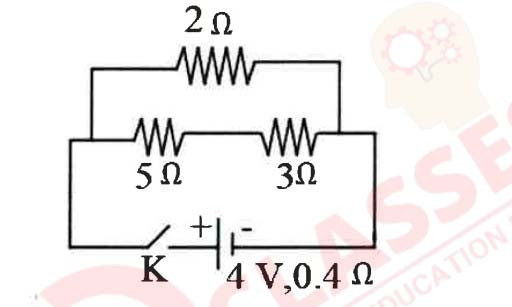
(a) Calculate the resistance of the circuit when the key K completes the circuit.
(b) Calculate the current through 3Ω resistance.
Solution
(i)


(ii)


(iii)


Question 9
(i) A metal piece present at 120°C is quickly dropped in a calorimeter of mass 80 g
containing 200 g of water at 30°C. The final temperature attained by the mixture is
40°C. Calculate the thermal capacity of the metal piece. [Specific heat capacity of
water = 4.2 Jg-1°C-1, Specific heat capacity of calorimeter = 0.4
Jg-1°C-1]
(ii) The diagram below shows a cooling curve for a substance:
(a) State the temperatures at which the substance condenses and solidifies
respectively.
(b) The temperature range in which the substance is in liquid state.
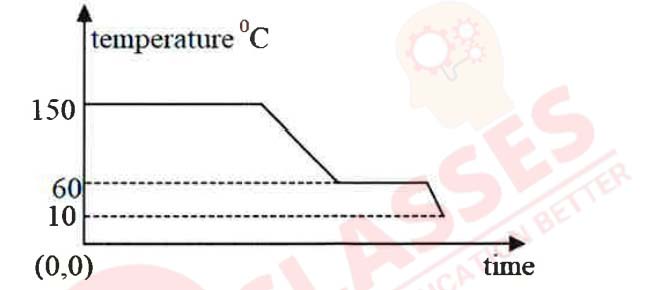
(c) Why do we prefer ice to ice-cold water for cooling a drink?
(iii) The diagram below shows a magnet placed between two coils A and B. The magnet
is moved along the axis towards coil B.
(a) State the polarities induced at the ends Q and R of the coil due to the motion
of the magnet.
(b) Name the phenomenon due to which the current is induced in the coils.
(c) Name the law which helps to find the polarities at the ends Q and R.

Solution
(i)


(ii)

(iii)


Add a comment